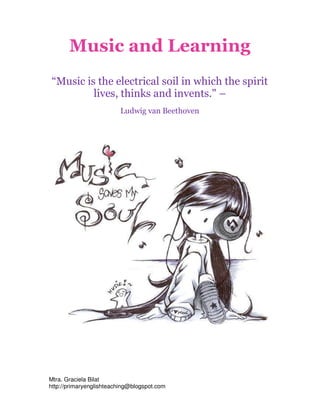
Correo De Las Lenguas Nº2
- 1. Music and Learning “Music is the electrical soil in which the spirit lives, thinks and invents." – Ludwig van Beethoven Mtra. Graciela Bilat http://primaryenglishteaching@blogspot.com
- 2. RESONATING WITH OUR LEARNING We all know how greatly music affects our feelings and energy levels! Without even thinking about it, we use music to create desired moods-- to make us happy, to enjoy movement and dance, to energize, to bring back powerful memories, to help us relax and focus. Music is a powerful tool for our personal expression within our daily lives- - it helps "set the scene" for many important experiences. Throughout time, people have recognized and intentionally used the powerful effects of sound. I believe that music greatly affects and enhances our learning and living! BRINGING EDUCATION TO LIFE WITH MUSIC How is it that for most people music is a powerful part of their personal life and yet when we go to work or school we turn it off? The intentional use of music in the classroom will set the scene and learning atmosphere to enhance our teaching and learning activities. Plus, using music for learning makes the process much more fun and interesting! Music, one of the joys of life, can be one of the joys of learning as well. Why don´t provide children with a symphony of learning opportunities and a sound education? Music helps us learn because it will-- • establish a positive learning state • create a desired atmosphere • build a sense of anticipation • energize learning activities • change brain wave states • focus concentration • increase attention • improve memory • facilitate a multisensory learning experience • release tension • enhance imagination • align groups • develop rapport • provide inspiration and motivation • add an element of fun • accentuate theme-oriented units Mtra. Graciela Bilat http://primaryenglishteaching@blogspot.com
- 3. WHAT ARE SPECIFIC WAYS MUSIC CAN BE USED IN THE CLASSROOM? Here are three areas of teaching where integrating music can be highly effective: LEARNING INFORMATION Music can be used to help us remember learning experiences and information. In Active Learning Experiences music creates a soundtrack for a learning activity. The soundtrack increases interest and activates the information mentally, physically, or emotionally. Music can also create a highly focused learning state in which vocabulary and reading material is absorbed at a great rate. When information is put to rhythm and rhyme these musical elements will provide a hook for recall. Here are three ways we can use music to help us learn information: ATTENTION, ATTITUDE AND ATMOSPHERE Certain music will create a positive learning atmosphere and help students to feel welcome to participate in the learning experience. In this way it also has great affect upon students' attitudes and motivation to learn. The rhythms and tempo of musical sound can assist us in setting and maintaining our attention and focus by perking us up when we are weary and helping us find peace and calm when we are over- energized in some way. PERSONAL EXPRESSION Music is the doorway to the inner realms and the use of music during creative and reflective times facilitates personal expression in writing, art, movement, and a multitude of projects. Creation of musical compositions offers a pathway to expressing personal feelings and beliefs in the language of musical sound. THE MULTIPLE INTELLIGENCES In 1983 Howard Gardner, psychology professor at Harvard University, presented his Multiple Intelligence theory based upon many years of research. Promoting the concept that intelligence is not one entity but that there are many different forms of Mtra. Graciela Bilat http://primaryenglishteaching@blogspot.com
- 4. intelligence, Gardner has awakened a revolution in learning. Multiple Intelligence teaching methods recognize eight (though there may be more) forms of intelligence: visual-spatial, linguistic, logical-mathematical, bodily-kinesthetic, interpersonal, intrapersonal, musical, and most recently naturalist. Multiple Intelligence teachers strive to broaden students familiarity and skill levels in each area. The Multiple Intelligence teaching model emphasizes education for understanding rather than rote memory or the mimicking of skills. Practical hands-on skill development is coupled with factual knowledge and the ability to apply skills and information in real-life situations and make meaningful contributions to society. Development of the musical intelligence can be greatly aided by the use of music throughout the curriculum. In addition to learning about musical elements and how to create music, the musical intelligence involves developing an ability to respond to musical sound and the ability to use music effectively in one's life. The more students listen and respond to a variety of music, the more they will know about music on a personal, real-experience level, the deeper will be their understanding of why people throughout time and around the world create music, the greater will be their ability to use music productively in their lives, and the more eager they will be to develop their musical skills because they will understand, appreciate and enjoy music more! Music Bibliography and Suggested Reading Abramson, Robert M. Rhythm Games Book I. New York: Music and Movement Press, 1973. Andersen, Ole, Marcy Marsh and Dr. Arthur Harvey. Learn with the Classics: Using Music to Study Smart at Any Age. LIND Institute, San Francisco, California: 1999. Bamberger, Jeanne. The Mind Behind the Musical Ear: How Children Develop Musical Intelligence. Boston, Massachusetts: Harvard University Press, 1991. Berard, Guy, M.D. Hearing Equals Behavior. New Canaan, Connecticut: Keats Publishing, 1993. Bjorkvold, Jon-Roar. The Muse Within: Creativity and Communication, Song and Play from Childhood through Maturity. New York: HarperCollins, 1989. Brewer, Chris. Music and Learning: Seven Ways to Use Music in the Classroom. Tequesta, Florida: LifeSounds, 1995 Campbell, Don G. Introduction to the Musical Brain, 2nd edition. St. Louis, Missouri: MMB Music Inc., 1983. Mtra. Graciela Bilat http://primaryenglishteaching@blogspot.com
